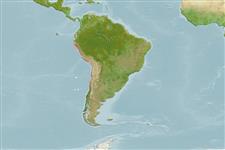Common names from other countries
Environment: milieu / climate zone / depth range / distribution range
экология
; пределы глубины 0 - 20 m (Ref. 114693). Tropical, preferred 15°C (Ref. 107945); 5°S - 43°S, 81°W - 70°W (Ref. 114682)
Southern Pacific: From Sechura, Peru to Chiloé, Chile. Tropical and subtropical.
Length at first maturity / Size / Вес / Возраст
Maturity: Lm ? range ? - ? cm Max length : 7.0 cm ShL самец/пол неопределен; (Ref. )
Lives in the swash zone of exposed high-energy intermediate and dissipative sandy beaches. Usually burrows to a depth of around 10 cm, but can reach 25 cm if disturbed. Adults are mainly restricted to the surf zone while most of the juveniles to the swash zone (Ref. 106909). Intertidal to subtidal (Ref. 113820).
Life cycle and mating behavior
половая зрелость | размножение | нерест | икра | Fecundity | личинки
Members of the class Bivalvia are mostly gonochoric, some are protandric hermaphrodites. Life cycle: Embryos develop into free-swimming trocophore larvae, succeeded by the bivalve veliger, resembling a miniature clam.
Основная ссылка
ссылки | координатор | соавторы
SAUP Database. 2006. (Ref. 356)
Статус Красного Списка МСОП (Ref. 130435)
Статус СИТЕС (Ref. 108899)
Not Evaluated
Not Evaluated
Использование человеком
рыболовство: коммерческий
FAO - рыболовство: landings | FishSource | Sea Around Us
инструменты
дополнительная информация
Возраст/РазмерыростЗависимость между длиной и массой телаЗависимость между длинамиморфологияличинкичисленность
ресурсы в Интернет
Estimates based on models
Preferred temperature
(Ref.
115969): 11.8 - 21.9, mean 17.4 (based on 30 cells).
устойчивость к внешним воздействиям
высокий, минимальное время удвоения популяции до 15 месяцев (K=1.13).
Уязвимость
Low vulnerability (10 of 100).
